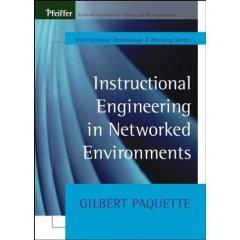| 2020ok Directory of FREE Online Books and FREE eBooks |
Free eBooks > Computers & Internet > Web Development > Platforms & Administration > Web Servers > General > Instructional Engineering in Networked Environments
Instructional Engineering in Networked Environmentsby Gilbert Paquette  Download Book (Respecting the intellectual property of others is utmost important to us, we make every effort to make sure we only link to legitimate sites, such as those sites owned by authors and publishers. If you have any questions about these links, please contact us.) link 1 About Book Review “The tools and methods developed by Dr. Paquette and his team at LICEF since 1992 are generally regarded by the International Board of Standards for Training, Performance and Instruction (IBSTPI) as world class in every respect. The board believes that an institution or organization embarking on serious efforts in distance and distributed learning would do well to consider these methods and tools as setting a standard.” —J. Michael Spector, Syracuse University; and executive vice president, IBSTPI “Gilbert Paquette’s work is truly world leading and needs much more exposure. I was so impressed with his detailed models for knowledge engineering in telelearning systems. It was the first time in years that I thought someone had created a breakthrough.” —Anne Forster, director, innovation and technology, vice chancellor’s office, University of Sydney, Australia “Hydro-Quebec groups over 19,500 employees and employs a staff of around 300 trainers and instructional designers. We have been using the MISA method and the MOT knowledge editor for several years now and we ha ve not yet found a method as efficient, even though we have had many sales pitches by different vendors.” —Gilles Beaulieu, trans energie division, Hydro-Quebec “In this book, Professor Paquette provides one of the most sophisticated tools yet developed for a true technology of instructional engineering. All serious instructional designers will find that this work significantly improves the efficiency and effectiveness of their instructional development efforts.” —M. David Merrill, professor, department of instructional design, Utah State University
In this book, Gilbert Paquette–an internationally recognized expert in the field of technology-based training–offers IT professionals, trainers, and consultants a revolutionary method for going beyond simple information management. Instructional Engineering in Networked Environments introduces the instructional engineering method that elicits knowledge from subject matter experts to make information more widely available for training other people and transfering knowledge through formal and informal training using a variety of media and information sources. Throughout the book, Paquette shows that instructional engineering is based on the use of transferable graphic models that demonstrate how this engineering works in an environment with human networks and diversified information sources. This important book also includes illustrative examples of "artifacts"–the actual job aids that hold an organization’s knowledge–and provides numerous easily reproducible tools. Praise for Instructional Engineering in Networked Environments "The tools and methods developed by Dr. Paquette and his team at LICEF since 1992 are generally regarded by the International Board of Standards for Training, Performance and Instruction (IBSTPI) as world class in every respect. The board believes that an institution or organization embarking on serious efforts in distance and distributed learning would do well to consider these methods and tools as setting a standard." "Gilbert Paquette’s work is truly world-leading and needs much more exposure. I was so impressed with his detailed models for knowledge engineering in telelearning systems. It was the first time in years that I thought someone had created a breakthrough." "Hydro-Quebec groups over 19,500 employees and employs a staff of around 300 trainers and instructional designers. We have been using the MISA method and the MOT knowledge editor for several years now, and we have not yet found a method as efficient, even though we have had many sales pitches by different vendors." "In this book, Professor Paquette provides one of the most sophisticated tools yet developed for a true technology of instructional engineering. All serious instructional designers will find that this work significantly improves the efficiency and effectiveness of their instructional development efforts." Related Free eBooks
| Related Tags |












SEND A COMMENT
PLEASE READ: All comments must be approved before appearing in the thread; time and space constraints prevent all comments from appearing. We will only approve comments that are directly related to the article, use appropriate language and are not attacking the comments of others.